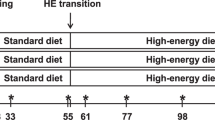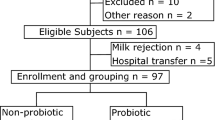Abstract
Purpose
An aberrant gut microbiome has been suggested to contribute to the worldwide epidemic of obesity. In animal models, the probiotic Lactobacillus paracasei ssp. paracasei F19 (LF19) induced upregulation of genes involved in energy homoeostasis, reduced body fat and altered the serum (S) lipoprotein profile. In our previous report, feeding LF19 to infants during weaning impacted the global plasma metabolome. LF19 lowered palmitoleic acid, a monounsaturated fatty acid associated with hypertriglyceridemia and increased visceral adiposity. Therefore, we assessed if feeding LF19 from 4 to 13 months of age would have long-term effects on body composition, growth and metabolic markers.
Methods
Of 179 children included in our baseline study, 120 entered the follow-up at 8–9 years of age, n = 58 in the probiotic and n = 62 in the placebo group. Body composition was measured using dual energy X-ray absorptiometry. Anthropometrics of the child and accompanying parent(s) were assessed. S-lipids, insulin, glucose and transaminases were determined after overnight fasting.
Results
LF19 did not affect body mass index z-score, sagittal abdominal diameter, fat-free mass, fat mass index, truncal fat %, android or gynoid fat % and had no long-term impact on any of the assessed metabolic markers (p > 0.05).
Conclusion
Feeding LF19 during infancy did not modulate body composition, growth or any of the assessed metabolic markers at school age. The steady increase in probiotic products targeting infants and children calls for long-term follow-up of initiated probiotic intervention studies.


Similar content being viewed by others
References
Berenson GS (2012) Health consequences of obesity. Pediatr Blood Cancer 58:117–121
Olds T, Maher C, Zumin S et al (2011) Evidence that the prevalence of childhood overweight is plateauing: data from nine countries. Int J Pediatr Obes 6:342–360
Gupta N, Goel K, Shah P, Misra A (2012) Childhood obesity in developing countries: epidemiology, determinants, and prevention. Endocr Rev 33:48–70
Ley RE, Bäckhed F, Turnbaugh P, Lozupone CA, Knight RD, Gordon JI (2005) Obesity alters gut microbial ecology. Proc Natl Acad Sci USA 102:11070–11075
Turnbaugh PJ, Ley RE, Mahowald MA, Magrini V, Mardis ER, Gordon JI (2006) An obesity-associated gut microbiome with increased capacity for energy harvest. Nature 444:1027–1031
Flint HJ (2011) Obesity and the gut microbiota. J Clin Gastroenterol 45(Suppl):S128–S132
Delzenne NM, Neyrinck AM, Bäckhed F, Cani PD (2011) Targeting gut microbiota in obesity: effects of prebiotics and probiotics. Nat Rev Endocrinol 9:639–646
Kalliomäki M, Collado MC, Salminen S, Isolauri E (2008) Early differences in fecal microbiota composition in children may predict overweight. Am J Clin Nutr 87:534–538
Rautava S, Luoto R, Salminen S, Isolauri E (2012) Microbial contact during pregnancy, intestinal colonization and human disease. Nat Rev Gastroenterol Hepatol 9:565–576
Yatsunenko T, Rey FE, Manary MJ et al (2012) Human gut microbiome viewed across age and geography. Nature 486:222–227
FAO/WHO (2001) Health and nutritional properties of probiotics in food including powder milk with live lactic acid bacteria. Report of a joint FAO/WHO expert consultation on evaluation of health and nutritional properties of probiotics in food including powder milk with live lactic acid bacteria
Nerstedt A, Nilsson EC, Ohlson K et al (2007) Administration of Lactobacillus evokes coordinated changes in the intestinal expression profile of genes regulating energy homeostasis and immune phenotype in mice. Br J Nutr 97:1117–1127
Aronsson L, Huang Y, Parini P et al (2010) Decreased fat storage by Lactobacillus paracasei is associated with increased levels of angiopoietin-like 4 protein (ANGPTL4). PLoS ONE 30:5
Chorell E, Karlsson Videhult F, Hernell O, Antti H, West CE (2013) Impact of probiotic feeding during weaning on the serum lipid profile and plasma metabolome in infants. Br J Nutr 110:116–126
Kunesova M, Hainer V, Tvrzicka E, Phinney SD, Stich V, Parizkova J, Zak A, Stunkard AJ (2002) Assessment of dietary and genetic factors influencing serum and adipose fatty acid composition in obese female identical twins. Lipids 37:27–32
Paillard F, Catheline D, Duff FL, Bouriel M, Deugnier Y, Pouchard M, Daubert JC, Legrand P (2008) Plasma palmitoleic acid, a product of stearoyl-coA desaturase activity, is an independent marker of triglyceridemia and abdominal adiposity. Nutr Metab Cardiovasc Dis 18:436–440
Okada T, Furuhashi N, Kuromori Y, Miyashita M, Iwata F, Harada K (2005) Plasma palmitoleic acid content and obesity in children. Am J Clin Nutr 82:747–750
West CE, Gothefors L, Granström M, Käyhty H, Hammarström ML, Hernell O (2008) Effects of feeding probiotics during weaning on infections and antibody responses to diphtheria, tetanus and Hib vaccines. Pediatr Allergy Immunol 19:53–60
FAO/WHO (2002) Guidelines for the evaluation of probiotics in food. Report of a joint FAO/WHO working group on drafting guidelines for the evaluation of probiotics in food. World Health Organization, London Ontario, Canada
The International Response to Helsinki V (2000) The WMA’s declaration of helsinki on ethical principles for medical research involving human subjects, as adopted by the 52nd WMA General Assembly. Edinburgh. http://www.wma.net/en/20activities/10ethics/10helsinki/intl_response_helsinki.pdf. Accessed 1 Oct 2013
Cole TJ, Bellizzi MC, Flegal KM, Dietz WH (2000) Establishing a standard definition for child overweight and obesity worldwide: international survey. BMJ 320:1240–1243
WHO (2011) World Health Organization AnthroPlus for persoenl computers manual: software for assessing growth of the world’s children and adolescents. Geneva From: http://www.who.int/growthref/tools/en/. Accessed 30 Dec 2012
de Onis M, Garza C, Victora CG, Onyango AW, Frongillo EA, Martines J (2004) The WHO multicentre growth reference study: planning, study design, and methodology. Food Nutr Bull 25:S15–S26
de Onis M, Onyango AW, Borghi E, Siyam A, Nishida C, Siekmann J (2007) Development of a WHO growth reference for school-aged children and adolescents. Bull World Health Organ 85:660–667
Fors H, Gelander L, Bjarnason R, Albertsson-Wikland K, Bosaeus I (2002) Body composition, as assessed by bioelectrical impedance spectroscopy and dual-energy X-ray absorptiometry, in a healthy paediatric population. Acta Paediatr 91:755–760
Wells JC (2001) A critique of the expression of paediatric body composition data. Arch Dis Child 85:67–72
Friedewald WT, Levy RI, Fredrickson DS (1972) Estimation of the concentration of low-density lipoprotein cholesterol in plasma, without use of the preparative ultracentrifuge. Clin Chem 18:499–502
Wallace TM, Levy JC, Matthews DR (2004) Use and abuse of HOMA modeling. Diabetes Care 27:1487–1495
Håglin L, Hagman U, Nilsson M (1995) Evaluation of the meal model “Matmallen”. A means of estimating consumed amounts of food. Scand J Nutr 39:79–83
Luoto R, Kalliomäki M, Laitinen K, Isolauri E (2010) The impact of perinatal probiotic intervention on the development of overweight and obesity: follow-up study from birth to 10 years. Int J Obes (Lond) 34:1531–1537
Luoto R, Laitinen K, Nermes M, Isolauri E (2010) Impact of maternal probiotic-supplemented dietary counselling on pregnancy outcome and prenatal and postnatal growth: a double-blind, placebo-controlled study. Br J Nutr 103:1792–1799
Abrahamsson TR, Jakobsson T, Björksten B, Oldaeus G, Jenmalm MC (2013) No effect of probiotics on respiratory allergies: a seven-year follow-up of a randomized controlled trial in infancy. Pediatr Allergy Immunol 24:556–561
Rabot S, Rafter J, Rijkers GT, Watzl B, Antoine JM (2010) Guidance for substantiating the evidence for beneficial effects of probiotics: impact of probiotics on digestive system metabolism. J Nutr 140:677S–689S
Million M, Maraninchi M, Henry M et al (2012) Obesity-associated gut microbiota is enriched in Lactobacillus reuteri and depleted in Bifidobacterium animalis and Methanobrevibacter smithii. Int J Obes (Lond) 36:817–825
Kadooka Y, Sato M, Imaizumi K et al (2010) Regulation of abdominal adiposity by probiotics (Lactobacillus gasseri SBT2055) in adults with obese tendencies in a randomized controlled trial. Eur J Clin Nutr 64:636–643
Kadooka Y, Sato M, Ogawa A et al (2013) Effect of Lactobacillus gasseri SBT2055 in fermented milk on abdominal adiposity in adults in a randomised controlled trial. Br J Nutr 110:1696–1703
Gueimonde M, Kalliomäki M, Isolauri E, Salminen S (2006) Probiotic intervention in neonates-will permanent colonization ensue? J Pediatr Gastroenterol Nutr 42:604–606
West CE, Hammarström ML, Hernell O (2013) Probiotics in primary prevention of allergic disease—follow-up at 8–9 years of age. Allergy 68:1015–1020
Million M, Raoult D (2013) The role of the manipulation of the gut microbiota in obesity. Curr Infect Dis Rep 15:25–30
Johnston BC, Goldenberg JZ, Vandvik PO, Sun X, Guyatt GH (2011) Probiotics for the prevention of pediatric antibiotic-associated diarrhea. Cochrane Database Syst Rev 9:CD004827
Trasande L, Blustein J, Liu M, Corwin E, Cox LM, Blaser MJ (2013) Infant antibiotic exposures and early-life body mass. Int J Obes (Lond) 37:16–23
Freedman DS, Sherry B (2009) The validity of BMI as an indicator of body fatness and risk among children. Pediatrics 124(Suppl 1):S23–S34
Forsum E, Flinke Carlsson E, Henriksson H, Henriksson P, Löf M (2013) Total body fat content versus BMI in 4-year-old healthy Swedish children. J Obes 2013:206715
Guzzaloni G, Minocci A, Marzullo P, Liuzzi A (2009) Sagittal abdominal diameter is more predictive of cardiovascular risk than abdominal fat compartments in severe obesity. Int J Obes (Lond) 33:233–238
Gustat J, Elkasabany A, Srinivasan S, Berenson GS (2000) Relation of abdominal height to cardiovascular risk factors in young adults: the Bogalusa heart study. Am J Epidemiol 151:885–891
Larsson C, Hernell O, Lind T (2011) Moderately elevated body mass index is associated with metabolic variables and cardiovascular risk factors in Swedish children. Acta Paediatr 100:102–108
Sampaio LR, Simoes EJ, Assis AM, Ramos LR (2007) Validity and reliability of the sagittal abdominal diameter as a predictor of visceral abdominal fat. Arq Bras Endocrinol Metabol 51:980–986
Flodmark CE, Shen W, Punyanitya M, Leander P, Lanke J, Pietrobelli A (2013) Laser beam measurement of abdominal sagittal diameter in obese children: a validation study. Pediatr Obes 8:112–117
Braegger C, Chmielewska A, Decsi T et al (2011) Supplementation of infant formula with probiotics and/or prebiotics: a systematic review and comment by the ESPGHAN committee on nutrition. J Pediatr Gastroenterol Nutr 52:238–250
Szajewska H (2011) Short- and long-term effects of probiotics administered early in life. Nestle Nutr Workshop Ser Pediatr Program 68:65–78; discussion 78–82
Hernell O, West C (2013) Clinical effects of probiotics: scientific evidence from a paediatric perspective. Br J Nutr 109:S70–S75
Acknowledgments
The authors wish to express their gratitude to the participating families; research nurses Åsa Sundström for excellent assistance in the follow-up clinics; Lena Uddståhl for assisting with the DEXA scans; research assistant Catarina Lundell for running the ELISA analyses. The present study was supported by Arla Foods AB, Denmark; through regional agreement between Umeå University and Västerbotten county council on cooperation in the field of Medicine; European Union’s Seventh Framework Programme under grant agreement no. 222720; Ekhaga and Oskar Foundations; the Swedish Society of Medical Research; Stiftelsen Samariten; Insamlingsstiftelsen at Umeå University. Arla Foods AB personnel were involved in discussions regarding study design. Sponsors had no involvement in the collection, analysis and interpretation of data, in writing the report or in the decision to submit the paper for publication. C. E. W and O. H were responsible for the design and funding of the project. C. E. W coordinated and supervised the study. F. K. V and H. S analysed the data. F. K. V, I. Ö and C. E. W wrote the manuscript. O. H and H. S contributed to the discussions. All authors read and approved the final manuscript.
Conflict of interest
Dr West has received funding and speaker honoraria from Arla Foods; speaker honoraria and travel assistance to attend conferences from Nestlé Nutrition. Prof Hernell is a member of the Scientific Advisory Board of Semper and Hero and has received funding from Semper AB and Arla Foods. The other authors declare no conflict of interest.
Author information
Authors and Affiliations
Corresponding author
Rights and permissions
About this article
Cite this article
Karlsson Videhult, F., Öhlund, I., Stenlund, H. et al. Probiotics during weaning: a follow-up study on effects on body composition and metabolic markers at school age. Eur J Nutr 54, 355–363 (2015). https://doi.org/10.1007/s00394-014-0715-y
Received:
Accepted:
Published:
Issue Date:
DOI: https://doi.org/10.1007/s00394-014-0715-y




